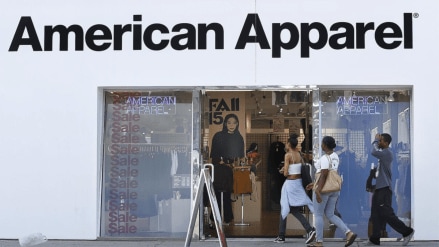Once a global symbol of youth counterculture and provocative branding, American Apparel is back in conversation, owing to TikTok’s recent love affair with all things “indie sleaze.” The revival of early-2000s aesthetics has triggered nostalgia for the brand’s high-waisted disco pants and rainbow-colored basics, but the story behind its rise and fall is far darker than the glossy sheen of retro fashion suggests.
In the latest episode of Netflix’s Trainwreck documentary series, titled The Cult of American Apparel, former employees of the company speak out about their time at one of the most controversial brands in recent retail history. The 54-minute documentary offers a sobering account of how American Apparel’s boundary-pushing image often crossed the line into exploitation, both in its advertising and its internal culture.
Founded in 1989 by Canadian-born entrepreneur Dov Charney, American Apparel began as a wholesale manufacturer that prided itself on being “sweatshop-free” and “Made in the USA.” The brand gained momentum in the early 2000s, opening hundreds of stores worldwide. According to Cosmopolitan, it was a staple of the indie sleaze aesthetic, with ads featuring real employees, porn stars, and amateur-looking photos that often blurred the line between edgy and inappropriate.
Charney, who was also the public face of the company, shot many of the ads himself. In a previously recorded interview cited by Cosmopolitan, he defended the voyeuristic and sexually suggestive tone of the campaigns: “People are going to buy into authenticity… The imperfect is often more appreciated than the perfect.” But many of the ads were banned, and criticism mounted over the objectification of young-looking models and the blurred boundaries between workplace and performance.
The company’s downfall began in earnest in 2014 when Charney was ousted by the board following multiple allegations of misconduct, claims he has repeatedly denied and for which he has never been tried. In its reporting, the Los Angeles Times described a “disturbing number of allegations” against Charney, including racist remarks, inappropriate behaviour with employees, and the possession of explicit footage on company devices.
Former workers interviewed in the Netflix documentary recall being hired with no prior experience and receiving onboarding packages that included items like vibrators and phones for 24/7 contact with Charney. Some described a toxic culture in which young employees, particularly women, were allegedly exploited. One clip reportedly shows Charney walking naked in front of staffers, while others recount being housed in his Los Angeles mansion known as the Garbutt House, which Netflix viewers now see as a blurred boundary between work and personal life.
Financial trouble soon followed. American Apparel filed for Chapter 11 bankruptcy in 2015. A year later, a takeover bid aligned with Charney was rejected, and the company was ultimately bought in 2017 for $88 million by Canadian firm Gildan Activewear. All 281 stores were shuttered, and the brand was relaunched as an online-only entity.
The brand’s last UK store, located in Camden, London, closed in 2017, ending its physical presence overseas. While American Apparel still operates online under new ownership and touts a commitment to sustainability and ethics, its manufacturing no longer takes place in Los Angeles, a core part of its original identity.
Charney, meanwhile, continues to work in fashion. In 2016, he launched Los Angeles Apparel, another made-in-USA brand that echoes American Apparel’s original blueprint. He has also collaborated with Kanye West’s Yeezy label, though he has since distanced himself following the rapper’s antisemitic remarks, Cosmopolitan reported.
As indie sleaze makes a comeback, so too does scrutiny of the culture that fueled American Apparel’s rise. With Netflix bringing its troubled history back into public view, the revival of the brand’s aesthetic may come with a necessary reckoning over the values that once made it iconic and infamous.
